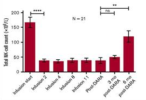This is a really interesting paper
Mitochondria are believed to have originated through an ancient endosymbiotic process in which proteobacteria were captured and co-opted for energy production and cellular metabolism. Mitochondria segregate during cell division and differentiation, ...

pmc.ncbi.nlm.nih.gov
Edit: thread on the paper now created
here
If I’m understanding and summarising correctly, as well as mitochondria being shared from parent to daughter cells, cells can also share mitochondria through intercellular mitochondria transfer, even between different cell types.
This can happen through direct physical contact using micro tubules.
Or indirectly with mitochondria either released in extracellular vesicles (Rab7/GDP status determines if a cell exports) or as free mitochondria. With phagocytosis used by other cells to capture and import them.
So a useful process when all is going well. But this has been shown to be hijacked by some cancers, hence daratumumab being useful, it can stop this sharing.
One possibility after reading this then is, could there be a loop whereby cells under some form of load or metabolic stress will bring in mitochondria from another cell, and if that cell has malfunctioning mitochondria, it hinders rather than helps, so perpetuates the loop.
This mitochondria transfer process occurs between cells of different types and both neural and immune cells are mentioned, which is handy.
Astrocytes have been shown to release these extracellular vesicle associated mitochondria (mentioned in the paper) and also mention of macrophages
transferring mitochondria to sensory neurons when there’s inflammatory signalling.
I’m not the first to think along these lines, in another thread I found when searching for mentions of RAB7
Is there then a possibility of —
Damaged mitochondria being shared around due to impaired mitophagy —> induction of more bad mitochondria (and impaired autophagy) in more cells ?
Edit: so part of a potential mechanism for daratumumab here would be to stop or at least reduce this sharing, to help break a loop there. It may well be that it’s also helping by tagging immune cells to be destroyed, but if it’s also helping stop sharing of dodgy mitochondria, perhaps even from these immune cells, that could be interesting.
Maybe something else to think about anyway. And possibly some links with other ideas floating around.


